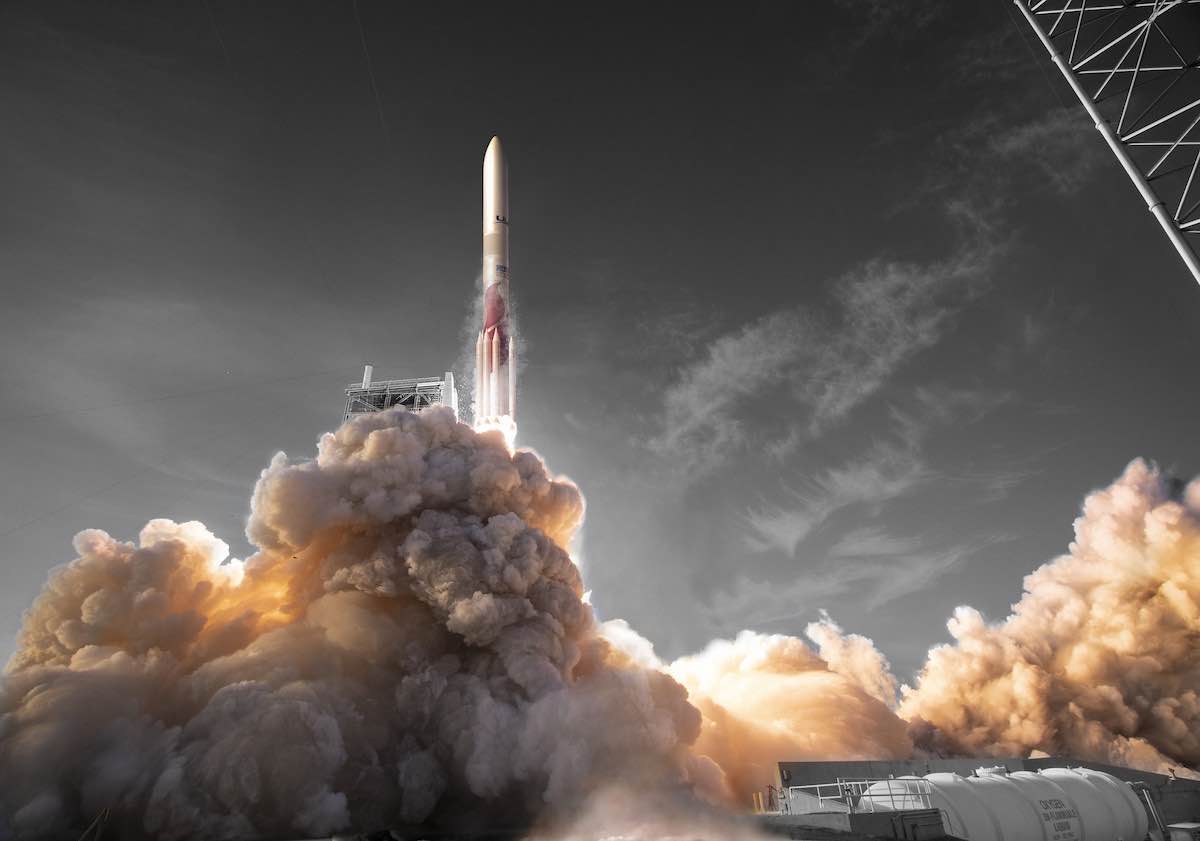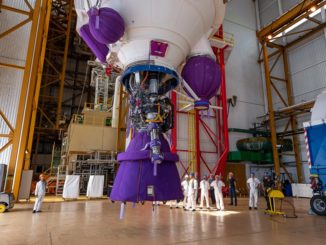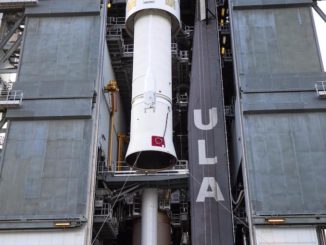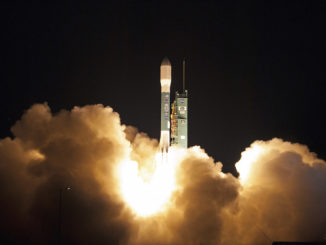EDITOR’S NOTE: See additional photos of the Vulcan booster at the bottom of this page.

United Launch Alliance’s first full-scale Vulcan booster with two Blue Origin BE-4 engines arrived at Cape Canaveral Space Force Station on Saturday, the first time in more than a decade that a core stage from a new family of orbital-class rockets has rolled into the Florida launch facility.
The 110-foot-long (33.5-meter) rocket stage rolled off of ULA’s “RocketShip” transport vessel Saturday at Port Canaveral, towed by a truck into nearby Cape Canaveral Space Force Station for a test campaign expected to last several months. ULA shipped the Pathfinder Tanking Test, or PTT, booster to Florida for fit checks and rehearsals with the Vulcan’s ground systems.
Built by ULA in Decatur, Alabama, the rocket is the company’s first flightworthy Vulcan booster. Two methane-fueled BE-4 development engines are attached to the rear end of the rocket, but they won’t be fired as part of the checkout campaign at Cape Canaveral.
The Vulcan Centaur rocket is ULA’s next-generation launch vehicle, and is destined to replace the company’s existing fleet of Atlas and Delta rockets. The new rocket can fly with zero, two, four, or six solid rocket boosters, ULA has developed an upgraded version of the venerable hydrogen-fueled Centaur upper stage to fly atop the Vulcan rocket.
“This is our future,” said Ron Fortson, ULA’s director and general manager of launch operation.
The Vulcan core stage measures 17.7 feet (5.4 meters) in diameter, and contains aluminum propellant tanks for methane and liquid oxygen for the dual BE-4 engines. ULA teams in Alabama are finishing work on the Vulcan booster and Centaur upper stage for the first launch later this year. The pathfinder operations beginning this weekend in Florida won’t include the Vulcan’s strap-on solid rocket motors or Centaur upper stage.
A fully-stacked Vulcan Centaur won’t appear on the Cape Canaveral horizon until the next Vulcan booster arrives at the launch site for the inaugural flight.
The rocket stage that arrived at Cape Canaveral this week will return to Alabama at the end of the pathfinder tests to be fitted with pair of flight-ready BE-4 engines, then return to Florida for a future launch, according to ULA.
The first stop for the Vulcan booster will be ULA’s Vertical Integration Facility, located about quarter-mile south of pad 41 at Cape Canaveral. A new mobile launch table, called the Vulcan Launch Platform, is inside the vertical hangar.

The 1.3-million-pound (589-metric ton) Vulcan Launch Platform rolled out to pad 41 for the first time last month for initial testing. Fortson said ULA plans to lift the Vulcan booster onto the mobile platform’s launch mount as soon as Sunday.
The VIF itself was modified with new work platforms over the last couple of years to fit the Vulcan booster, which is more than 5 feet (1.5 meters) wider than the Atlas 5 first stage. The changes allow the building — built more than 20 years ago — to accommodate both Atlas 5 and Vulcan Centaur rockets until ULA retires the Atlas family.
If everything goes according to plan, the Vulcan booster and its launch platform could roll out of the VIF to pad 41 later this month or in March, according to Fortson.
After connecting the launch platform and the rocket to gas and electrical systems at the pad, ULA engineers will run the Vulcan booster and the ground infrastructure through a series of exercises, culminating in loading of thousands of gallons of cryogenic liquid methane and liquid oxygen into the rocket.
In preparation for the arrival of the first Vulcan Centaur rocket, teams at pad 41 have installed a new methane fuel farm for the BE-4 engines. The Atlas 5’s first stage, powered by a Russian-built RD-180 engine, burns kerosene fuel in combination with liquid oxygen.
ULA also expanded the capacity of the liquid oxygen system at pad 41 to feed the larger oxidizer tanks in the Vulcan booster and the Centaur upper stage. Both the first and second stages contain larger propellant tanks than those on the Atlas 5 rocket, giving the Vulcan Centaur more payload lift capability.
Engineers upgraded the sound suppression water system at pad 41 for the more powerful Vulcan Centaur rocket, and also developed special electronics trailers for Vulcan to accompany the Vulcan Launch Platform to the seaside launch complex.
All those systems will be put to the test in the next few months, while ULA continues launching Atlas 5 rockets on operational missions.
A facility called the Spaceflight Processing Operations Center, a modified Titan rocket booster assembly building, will help ULA manage the dual Vulcan and Atlas operations.
“Trying to build a new rocket at the same time you’re launching rockets on the same pad, that’s not easy,” Fortson said.
In an example that ULA has one foot in the present and one foot in the future, the RocketShip vessel that delivered the Vulcan booster to Cape Canaveral also carried a first and second stage for an Atlas 5 launch later this year on the STP-3 mission the U.S. military, and a second stage for a Delta 4-Heavy flight next year.

While the Vulcan Launch Platform is currently in the VIF, the Atlas 5’s platform is in storage inside the SPOC. ULA will start stacking the Atlas 5 rocket for its next mission — set for liftoff from pad 41 on March 25 with Boeing’s Starliner crew capsule — before the end of the month. When the Atlas 5 platform is needed back in the VIF, the Vulcan Launch Platform and the test booster will likely roll over to the SPOC, where ground teams can perform additional checkouts.
The SPOC isn’t equipped with equipment to stack Atlas 5 or Vulcan Centaur rockets, but Fortson said ULA might add the capability if the launch rate requires two assembly buildings.
The launch of Starliner spacecraft in March will be the second unpiloted test flight of the Boeing-built crew capsule. Assuming a successful flight to the International Space Station, NASA could clear the spacecraft to carry astronauts on a demonstration mission in September, also set to launch on an Atlas 5. That would give NASA two U.S.-made crew vehicles to ferry astronauts to and from the space station, alongside SpaceX’s Crew Dragon spacecraft, which flew to the outpost with crews twice last year.
The Atlas 5 rocket typically rolls out to pad 41 a day or two before launch. That makes the launch pad available for Vulcan testing most of the time, and ULA could be ready for the first Vulcan fueling dress rehearsal before the Starliner mission late next month, Fortson said.
“It’ll be a shell game,” Fortson said.
“Vulcan can be out there doing the testing they want,” he said. “They’ve just got to move out of the way for a couple of days so we can move out there and launch, and we move back in and they can go right back out.”
The Vulcan Centaur’s first launch will carry a commercial lander from Pittsburgh-based Astrobotic, which is under contract with NASA to deliver experiments to the moon as a precursor to future human expeditions to the lunar surface. The Vulcan Centaur with Astrobotic’s Peregrine moon lander is scheduled to launch before the end of the year, ULA says.
“With all these capabilities, we are ready and excited to get this launch happening at the end of the fourth quarter here,” Fortson said.

The development of Blue Origin’s BE-4 engines has been driving the schedule for the first Vulcan launch. During a press conference in December, Tory Bruno, ULA’s CEO, said the BE-4 engines on the Vulcan pathfinder booster are “near flight configuration, but not the final, final design.”
Each BE-4 engine can generate about 550,000 pounds of thrust.
“In the summer, we will receive flight-configured BE-4 engines,” Bruno said in December. “Those are being built now.”
Blue Origin, founded by Amazon billionaire Jeff Bezos, is building the first batch of BE-4 engines at the company’s headquarters in Kent, Washington. BE-4 engines for future Vulcan missions, and launches of Blue Origin’s own New Glenn rocket, will be manufactured at a new factory in Huntsville, Alabama, not far from ULA’s rocket plant in Decatur.
“We are very very confident with that engine,” Bruno said. “The BE-4 is performing with better performance than we actually asked for. The flight configuration has many, many seconds, and minutes, of testing on it now, and it has just run wonderfully. So we are looking forward, hopefully, knock on wood, to a very quiet qualification test run, and we’ll be off to space.”
The pathfinder testing is designed to ensure there are no surprises or major delays when ULA kicks off the first Vulcan launch campaign.
“We don’t really like to ad lib anything in our rocket factory, so every move that is made is in a process that itself has been proofed, and tried, and certified, and then locked down in configuration,” Bruno said in December. “So what we’re doing in this initial pass through, that I call pathfinding, is making sure that all of that is exactly perfect, that if there’s something we don’t like about the tooling, we modify the tooling and try again.
“If there’s anything we want to change in the process, we’ll do that,” Bruno said. “And that goes all the way from one end of the factory to the other. And then the same thing happens to get the rocket onto the RocketShip, to monitor it and safeguard it as it travels out to the cape, get it off the ship, onto the (Vulcan Launch Platform).
The platform “has dozens of active systems that supply gases and water for the acoustic suppression system, and instrumentation and monitoring,” Bruno said. “It’s not just to a big structure with wheels on it. It’s a big complicated machine in its own right, as is the VIF, and so on.”
“All of that is being worked off with these pathfinder engines, right up to (just) short of the flight readiness firing, and then at the last minute, we’re able to bring in the flight engines and take him through that whole evolution that has already been trailblazed for them,” Bruno said.
ULA unveiled the Vulcan rocket in 2015. It’s designed for a new era in the U.S. launch industry marked by increased competition, particularly from SpaceX, and a changing market.
“Atlas and Delta have kind of been the backbone of launch and have a lot of heritage over the last decade for the nation, and now it’s kind of fitting that we have a new rocket here, the Vulcan, that’s going to be continuing to build upon that legacy and bringing new capabilities to the nation,” Fortson said Saturday.
The U.S. military is an anchor customer for ULA, a 50-50 joint venture formed in 2006 by Boeing and Lockheed Martin. Pentagon officials announced last August that ULA will get 60 percent of the military’s most critical satellite launch contracts awarded through late 2024 for missions that will take off between 2022 and late 2027.
SpaceX will receive 40 percent of the national security launch contracts over the same period, giving the Pentagon two independent companies capable of serving all the military’s medium- and heavy-lift launch needs.
The agreements with ULA and SpaceX cover contracts to launch satellites for the U.S. Space Force, the National Reconnaissance Office, the Missile Defense Agency, and other military services and agencies.

ULA’s Vulcan Centaur rocket, once certified by the Space Force, will take up the lion’s share of the military’s large space missions. SpaceX’s Falcon 9 and Falcon Heavy rockets will also get lucrative military launch contracts.
“Atlas and Delta satisfy all the requirements needed to meet all of our customers’ needs today,” Fortson said. “But it takes us two rockets to do that. With Vulcan Centaur, we’ll be able to meet all those demanding requirements just with that vehicle by itself, including the Delta 4-Heavy requirement. They’ll all be satisfied by Vulcan Centaur.”
ULA plans to launch four more Delta 4-Heavy missions through 2023 with classified NRO spy satellite payloads. The Atlas 5 rocket, which is less expensive than the Delta 4, will also be retired in a few years.
The Vulcan Centaur will be less costly to build and fly than either of ULA’s current rocket types.
According to ULA, the new rocket’s heaviest configuration can loft about 60,000 pounds, or 22.7 metric tons, into low Earth orbit at an altitude of about 120 miles (200 kilometers). With the restartable, long-duration Centaur upper stage, the most powerful Vulcan variant can deliver roughly 15,900 pounds (7.2 metric tons) of payload directly into a circular geostationary orbit more than 22,000 miles (nearly 36,000 miles) over the equator.
ULA plans to retrieve the BE-4 rocket engines on future Vulcan Centaur missions, using a helicopter to capture the severed engine section in mid-air. That would allow ULA to reuse the engines on multiple missions, without reserving propellants for landing maneuvers to recover and reuse the entire booster, a technique now proven by SpaceX.
But early Vulcan missions won’t include engine recovery, while engineers collect data on the environments the BE-4s will see in flight.
“Our booster is a much more powerful booster that flies farther downrange, to higher altitudes, and higher velocities (than SpaceX’s booster),” Bruno said. “I don’t know exactly how many flights we’re going to need to collect that data.”
Engine recovery and reuse “is certainly on our technology roadmap,” Bruno said. “We’re actively working it now, and I expect tha we’ll be able to do it at the appropriate time.”







Email the author.
Follow Stephen Clark on Twitter: @StephenClark1.



